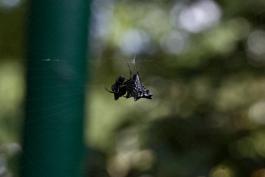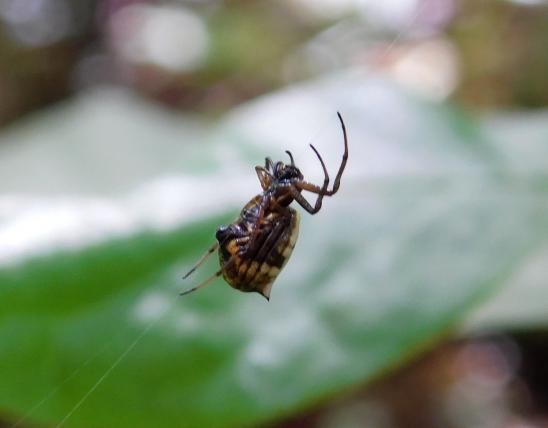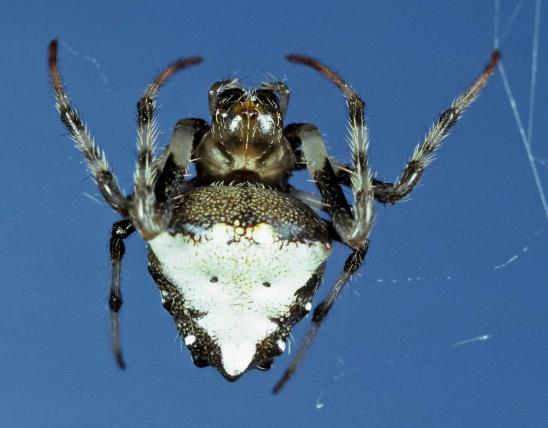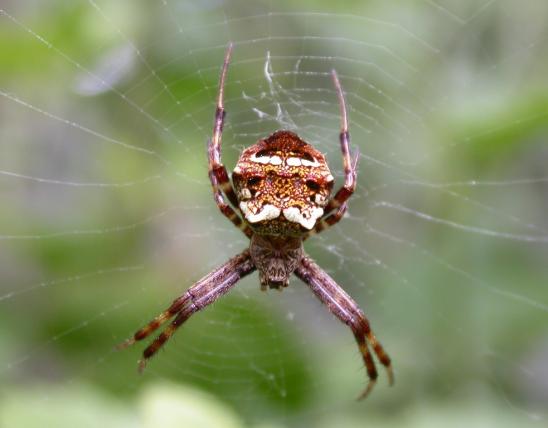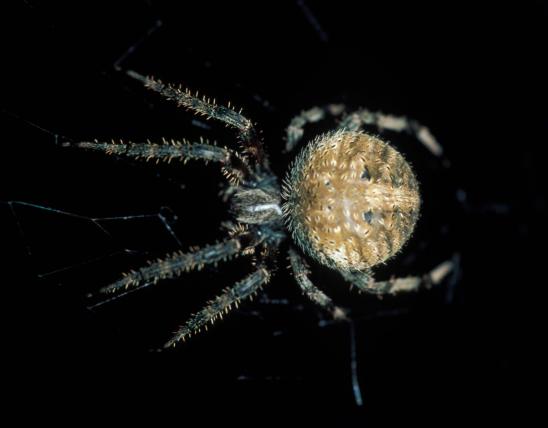
The spined micrathena is one of three species of spiny orbweavers (genus Micrathena) in Missouri. Its colors vary from whitish to yellowish, mottled with black or brown. The ten-spined, chunky abdomen sets the female spined micrathena apart from all other spiders. The carapace is amber, and the legs are glossy black.
Males of this species are seldom seen. They are much smaller and do not spin webs. Their abdomens lack spines and are instead simply elongated and dark. Most people who see them find them courting in the webs of females.
Orbweavers, including this one, spin wheel-shaped webs that are usually positioned vertically. This species tends to hang with its "back" or "top" toward the ground and the spinnerets pointing upward, with the abdomen looking like a tiny pyramid. Also like other orbweavers, Micrathena gracilis typically has one very long silk thread leading to a leaf or branch above the web. This is the spider's escape line, and it comes in handy when a bird or a hiker blunders into the web.
Similar species: Two other species of Micrathena occur in Missouri, the arrowshaped micrathena (M. sagittata) and the white micrathena (M. mitrata). The arrowhead spider (Verrucosa arenata) might also be confused with micrathena spiders. The females of these species are all easily distinguished by comparing photos.
Length (not including legs): females to about ⅜ inch; males only about ⅛ inch.
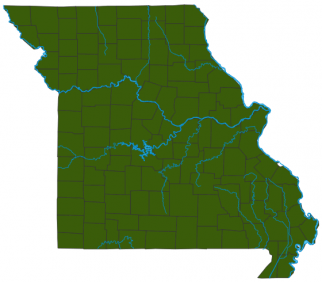
Statewide in woodland areas, although it is more common in central and southern Missouri, where timber is more extensive.
Habitat and Conservation
This species is commonly seen during woodland walks in August and September, as the females take advantage of the open space right in the center of human hiking trails, which flying insects use as corridors, too. This and the arrowhead spider (or triangle orbweaver) are two of the spiders most commonly run into by hikers. Spined micrathenas are also often seen in yards and other places where trees and bushes create appropriate open areas for them to spin their circular webs. Micrathenas almost never enter houses.
Food
The web is a delicate, closely woven orb (wheel-shaped web) with a pattern specialized for catching minute flying insects such as gnats, mosquitoes, and leafhoppers.
Life Cycle
As a general rule, spiders in our area hatch from eggs in spring and spend the growing season eating, maturing, mating and laying eggs. Females are capable of creating webs; males are not. Females continue creating egg cases as long as the weather holds out. As temperatures cool in fall, their metabolism slows, and they generally die when it freezes. Egg cases overwinter, and spiderlings hatch in spring.
Human Connections
It would be easy to dismiss the importance of these tiny predators, but once you have been plagued by the tiny insects they prey on, such as gnats and mosquitoes, you become thankful for their role in limiting such pests.
Ecosystem Connections
Spiders are little predators that help to control populations of the insects they capture. Being small themselves, they easily fall prey to larger predators such as birds, reptiles, and mammals. Many animals eat their eggs. Hummingbirds, vireos, and warblers steal webs from spiders and use them to build their own nests.






